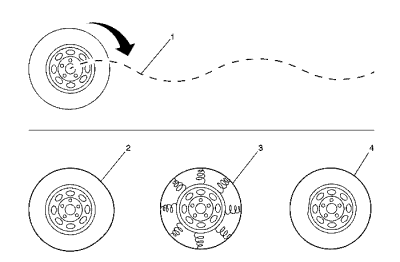Spark |
||||||||
|
|
|
|||||||

Wheel imbalance causes most highway speed vibration problems. A vibration can remain after dynamic balancing because:
| • | A tyre is out of round (2). |
| • | A rim is out of round (4). |
| • | A tyre stiffness variation exists (3). |
Measuring tyre and wheel free runout will uncover only part of the problem. All three causes, known as loaded radial runout (1), must be checked using a method of substituting known good tyre and wheel assemblies on the problem vehicle.
Low-speed variations, which occur below 64 km/h (40 mph), are usually caused by runout. High-speed vibrations, which occur above 64 km/h (40 mph), can be caused by either imbalance or runout.
There are two ways to correct properly balanced tyres which still vibrate. One method uses an automatic machine which loads the tyre and buffs small amounts of rubber from high spots on the outer 2 tread rows. Correction by this method is usually permanent and, if it is done properly, does not significantly affect the appearance or the tread life of the tyre. Tire truing with a blade type machine is not recommended because it substantially reduces the tread life and often does not correct the problem permanently.
Another method is to dismount the tyre and rotate it 180 degrees on the rim. Do this only on the tyre and wheel assemblies which are known to be causing a vibration because this method is just as likely to cause good assemblies to vibrate.
| © Copyright Chevrolet. All rights reserved |